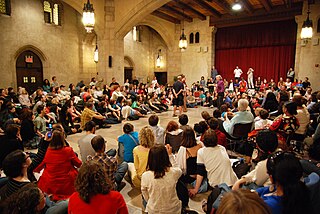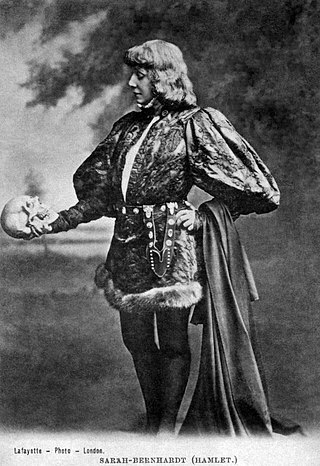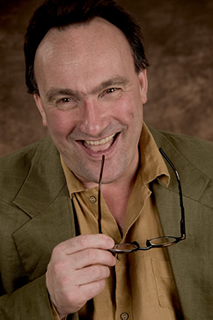
Improvisational theatre, often called improvisation or improv, is the form of theatre, often comedy, in which most or all of what is performed is unplanned or unscripted, created spontaneously by the performers. In its purest form, the dialogue, action, story, and characters are created collaboratively by the players as the improvisation unfolds in present time, without use of an already prepared, written script.

The following outline is provided as an overview of and topical guide to theatre:

Augusto Boal was a Brazilian theatre practitioner, drama theorist, and political activist. He was the founder of Theatre of the Oppressed, a theatrical form originally used in radical left popular education movements. Boal served one term as a Vereador in Rio de Janeiro from 1993 to 1997, where he developed legislative theatre.
Community theatre refers to any theatrical performance made in relation to particular communities—its usage includes theatre made by, with, and for a community. It may refer to a production that is made entirely by a community with no outside help, or a collaboration between community members and professional theatre artists, or a performance made entirely by professionals that is addressed to a particular community. Community theatres range in size from small groups led by single individuals that perform in borrowed spaces to large permanent companies with well-equipped facilities of their own. Many community theatres are successful, non-profit businesses with a large active membership and, often, a full-time staff. Community theatre is often devised and may draw on popular theatrical forms, such as carnival, circus, and parades, as well as performance modes from commercial theatre. This type of theatre is ever-changing and evolving due to the influences of the community; the artistic process can often be heavily affected by the community's socioeconomic circumstances.
Psychodrama is an action method, often used as a psychotherapy, in which clients use spontaneous dramatization, role playing, and dramatic self-presentation to investigate and gain insight into their lives. Developed by Jacob L. Moreno and his wife Zerka Toeman Moreno, psychodrama includes elements of theater, often conducted on a stage, or a space that serves as a stage area, where props can be used. A psychodrama therapy group, under the direction of a licensed psychodramatist, reenacts real-life, past situations, acting them out in present time. Participants then have the opportunity to evaluate their behavior, reflect on how the past incident is getting played out in the present and more deeply understand particular situations in their lives.

Experimental theatre, inspired largely by Wagner's concept of Gesamtkunstwerk, began in Western theatre in the late 19th century with Alfred Jarry and his Ubu plays as a rejection of both the age in particular and, in general, the dominant ways of writing and producing plays. The term has shifted over time as the mainstream theatre world has adopted many forms that were once considered radical.

Drama therapy is the use of theatre techniques to facilitate personal growth and promote mental health. Drama therapy is used in a wide variety of settings, including hospitals, schools, mental health centers, prisons, and businesses. Drama therapy, as a modality of the creative arts therapies, exists in many forms and can apply to individuals, couples, families, and various groups.
Dramatic conventions are the specific actions and techniques the actor, writer or director has employed to create a desired dramatic effect or style.
Playback Theatre is an original form of improvisational theatre in which audience or group members tell stories from their lives and watch them enacted on the spot.
Theatre for development (TfD) is a type of community-based or interactive theatre practice that aims to promote civic dialogue and engagement.

The Theatre of the Oppressed (TO) describes theatrical forms that the Brazilian theatre practitioner Augusto Boal first elaborated in the 1970s, initially in Brazil and later in Europe. Boal was influenced by the work of the educator and theorist Paulo Freire and his book Pedagogy of the Oppressed. Boal's techniques use theatre as means of promoting social and political change in alignment originally with radical-left politics and later with centre-left ideology. In the Theatre of the Oppressed, the audience becomes active, such that as "spect-actors" they explore, show, analyse and transform the reality in which they are living.
A theatre practitioner is someone who creates theatrical performances and/or produces a theoretical discourse that informs their practical work. A theatre practitioner may be a director, dramatist, actor, designer or a combination of these traditionally separate roles. Theatre practice describes the collective work that various theatre practitioners do.
Interactive theatre is a presentational or theatrical form or work that breaks the "fourth wall" that traditionally separates the performer from the audience both physically and verbally.

Drama is the specific mode of fiction represented in performance: a play, opera, mime, ballet, etc., performed in a theatre, or on radio or television. Considered as a genre of poetry in general, the dramatic mode has been contrasted with the epic and the lyrical modes ever since Aristotle's Poetics —the earliest work of dramatic theory.

Theatre or theater is a collaborative form of performing art that uses live performers, usually actors or actresses, to present the experience of a real or imagined event before a live audience in a specific place, often a stage. The performers may communicate this experience to the audience through combinations of gesture, speech, song, music, and dance. It is the oldest form of drama, though live theatre has now been joined by modern recorded forms. Elements of art, such as painted scenery and stagecraft such as lighting are used to enhance the physicality, presence and immediacy of the experience. Places, normally buildings, where performances regularly take place are also called "theatres", as derived from the Ancient Greek θέατρον, itself from θεάομαι.
Forum theatre is a type of theatre created by Brazilian theatre director Augusto Boal. It is one of the techniques under the umbrella term of Theatre of the Oppressed (TO). This relates to the engagement of spectators influencing and engaging with the performance as both spectators and actors, termed "spect-actors", with the power to stop and change the performance. As part of TO, the issues dealt with in forum theatre are often related to areas of social justice, with the aim of exploring solutions to oppression featured in the performance.
Open-space Learning, or OSL, is a pedagogic methodology. OSL is a transdisciplinary pedagogy that is dependent on the use of physically open spaces - in the sense that tables and chairs are absent - and an open approach to intellectual content and the role of the tutor. Participants in OSL, typically but not exclusively, learn in an 'embodied' way.
Theatre pedagogy is an independent discipline combining both theatre and pedagogy. As a field that arose during the 20th century, theatre pedagogy has developed separately from drama education, the distinction being that the drama teacher typically teaches method, theory and/or practice of performance alone, while theatre pedagogy integrates both art and education to develop language and strengthen social awareness. Theatre pedagogy is rooted in drama and stagecraft, yet works to educate people outside the realm of theatre itself.
There are many methods for teaching drama. Each strategy involves varying levels of student participation.

Paul Newham is a retired British psychotherapist known for developing techniques used in psychology and psychotherapy that make extensive use of the arts to facilitate and examine two forms of human communication: the interpersonal communication through which people speak aloud and listen to others, and the intrapersonal communication that enables individuals to converse silently with themselves. His methods emphasise the examination of traumatic experiences through literary and vocal mediums of expression, including creative writing, storytelling, and song. He is cited by peers as a pioneer in recognition of his original contribution to the expressive therapies.








